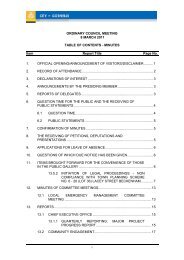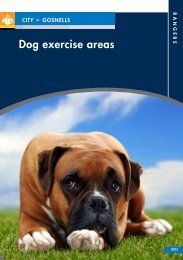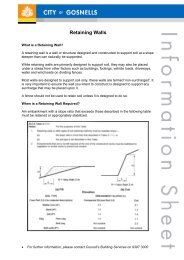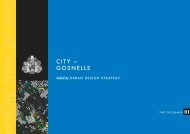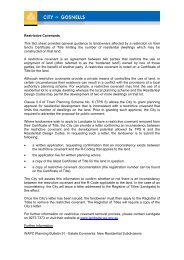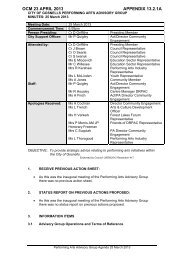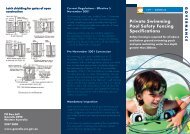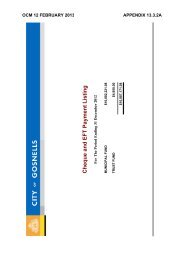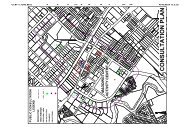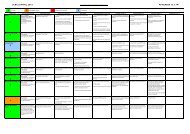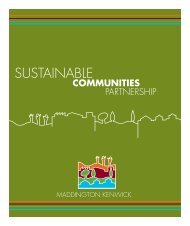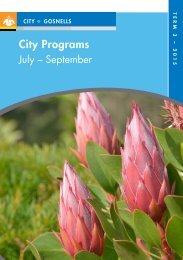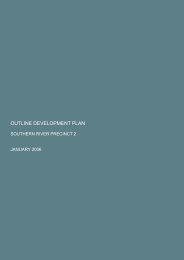Summary - City of Gosnells
Summary - City of Gosnells
Summary - City of Gosnells
Create successful ePaper yourself
Turn your PDF publications into a flip-book with our unique Google optimized e-Paper software.
Vegetation 67Map Unit& Total HaSL30.44Vegetation DescriptionAcacia lasiocarpa - Actinostrobus pyramidalis mid-dense heath andopen, species-rich rushes, sedges and herbs.Study Sites(species richness)Site 4 (67 spp.)Vegetation ConditionVery goodSL40.42Melaleuca lateriflora – M. brevifolia - Hypocalymma angustifoliummid-dense heath over species-rich herbs.Site 11 (56 spp.)Very goodSL50.32Pericalymma ellipticum mid-dense heath over open, species-richrushes, sedges and herbs.Site 7 (20 spp.)GoodSL61.50Hypocalymma angustifolium and other low, open to mid-denseshrubs over alien understorey.n/aDegradedSL70.28Tecticornia indica subsp. bidens low open shrubs and otherhalophytes over alien understorey.n/aDegradedRushes and SedgelandsR-S13.1Meeboldina cana – Chaetanthus aristatus mid-dense, species-richrushes, sedges and open herbs and Viminaria juncea tall open shrubs.Site 6 (35 spp.)Site 13Site 14 (35 spp.)Site 18Adj. to Site 28Very goodGoodGoodNow clearedGood5.2.2 Vegetation <strong>of</strong> the MKSEA in comparison to vegetation within the localconservation estateMany <strong>of</strong> the vegetation units that were recorded in the current MKSEA survey (T1, T4, T8, T11, ST2, ST3,ST4, ST5, ST6, SL2, SL3, SL4, SL5 and RS1) were similar to those recorded by other workers in BFS 387(Table 5.4).A number <strong>of</strong> vegetation units recorded in the current MKSEA survey (T3, T9, T12, ST1, SL6, and SL7)were relatively degraded units and there were insufficient data to fully evaluate them with regard topreviously recorded vegetation in the district. This vegetation was valuable as it included genetic resources,provided habitat for native fauna and could potentially be replanted and form valuable links between areas <strong>of</strong>high conservation value and wetland buffer zones. The resilience <strong>of</strong> native vegetation on the eastern side <strong>of</strong>the Swan Coastal Plain and its potential for regeneration subsequent to appropriate weed control have beenshown to be high (Brown et al., 2008); therefore, some <strong>of</strong> the weedy “degraded” vegetation <strong>of</strong> the MKSEAcould, potentially, be restored with appropriate management.There were, however, seven unusual vegetation types (T2, T5, T6, T7, T10, M1 and SL1) recorded in thecurrent survey <strong>of</strong> the MKSEA that have not been recorded previously in BFS 387 or in BFS 53. Four <strong>of</strong> theseunusual vegetation units (T5, T6, M1 and SL1) were in sites where calcareous materialwas recorded in thissurvey in the sediments underlying the sites. The unusual vegetation types recorded in the MKSEA are listedbelow.1. Vegetation Unit T2: Corymbia calophylla low open forest over open Xanthorrhoea preissii and openAnarthria laevis - Cytogonidium leptocarpoides rushes and sedges. This unit was similar to FCT 3a thathas been recorded in BFS 387. It was a Marri low forest located on seasonally waterlogged soils andincluded many <strong>of</strong> the floristic indicator species typical <strong>of</strong> FCT 3a (such as Kingia australis,Pericalymma ellipticum and Philotheca spicata). However, the understorey <strong>of</strong> this vegetation wasdominated two native rushes Anarthria laevis - Cytogonidium leptocarpoides that are very uncommonon the Swan Coastal Plain. It is most likely to be one the vegetation types that have been almost totallycleared on the ESCP but were part <strong>of</strong> the group <strong>of</strong> vegetation types that is represented in Gibson et al.,(1994) as FCT 3a.2. Vegetation Unit T5: Melaleuca rhaphiophylla - M. preissiana - low open forest over Cyathochaetateretifolia closed sedges. This vegetation was an unusual unit that was only recorded from one area inthe MKSEA in association with calcareous sediments. This type <strong>of</strong> vegetation is not present in BFS 387or BFS 53 and has not been recorded elsewhere within Bush Forever Sites on the Pinjarra Plain(Government <strong>of</strong> Western Australian, 2000). It appears to be most similar in floristics and habitat tovegetation recorded in the Bassendean Dunes at the Egerton Mound Spring in Ellenbrook (GovernmentTauss, C. and Weston, A.S. (2010). The flora, vegetation and wetlands <strong>of</strong> the Maddington-Kenwick Strategic Employment Area.A survey <strong>of</strong> the rural lands in the vicinity <strong>of</strong> the Greater Brixton Street Wetlands. Report to the <strong>City</strong> <strong>of</strong> <strong>Gosnells</strong>, W.A. Version 18.04.10



